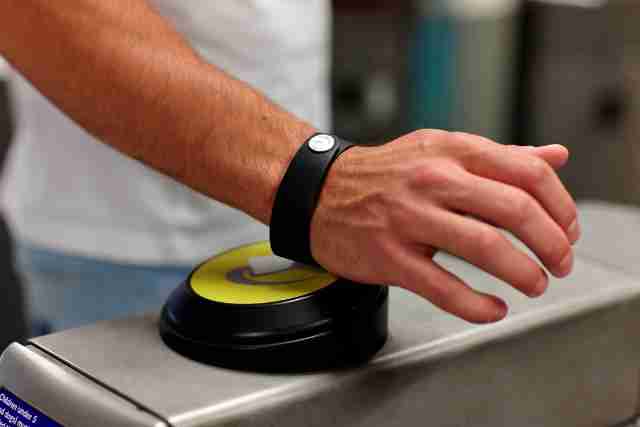The wearable payments market is experiencing a remarkable transformation, reshaping the way consumers engage in financial transactions. With growing consumer demand for convenience, speed, and hygiene, wearable payment devices such as smartwatches, fitness trackers, rings, and even clothing are becoming mainstream tools in the financial ecosystem.
The current scenario of the wearable payments market highlights a dynamic mix of technological advancement, strategic partnerships, and regional expansion. As more users embrace contactless payments and banks invest in digital solutions, the market is witnessing rapid growth and significant innovation. This article explores the current landscape of the wearable payments market, including key players, user trends, challenges, and regional developments.

1. Current Market Overview
The global wearable payments market was valued at approximately USD 12–15 billion in 2023 and is expected to grow at a CAGR of 20–25% over the next several years. This growth is propelled by an increasing shift toward digital payment methods, rising consumer tech awareness, and the adoption of smart devices.
Wearable payment solutions leverage Near Field Communication (NFC) and tokenization technology to allow users to make contactless payments directly from their wearables. With digital wallets like Apple Pay, Google Wallet, and Samsung Pay becoming ubiquitous, wearable integration has become the next frontier in fintech convenience.
2. Key Industry Players Shaping the Market
Several global technology giants and fintech companies dominate the current wearable payments market scenario:
Apple Inc.: A clear market leader with Apple Watch integrated with Apple Pay. Its seamless ecosystem is a major competitive advantage.
Samsung Electronics: Offers Samsung Pay on Galaxy wearables, with broader merchant compatibility due to NFC and MST technologies.
Google (Alphabet Inc.): Through Wear OS and Fitbit Pay, Google is increasing its footprint, especially in Android-dominant regions.
Garmin and Fitbit: Popular among fitness enthusiasts, these brands offer wearable payment support across major banking institutions.
In addition, niche players like K Ring, Token, and Fidesmo are gaining traction with innovative wearable formats, such as payment rings and passive NFC wristbands.
3. Consumer Trends and Market Demand
One of the strongest forces behind the market’s expansion is changing consumer behavior:
Contactless Preference: Post-pandemic, users are increasingly opting for hygienic, contact-free payment methods.
Tech-Savvy Generations: Millennials and Gen Z are quick adopters of wearable tech, often looking for multifunctionality in a single device.
Health and Finance Integration: Consumers are drawn to devices that combine health tracking with payment capabilities, creating a seamless lifestyle tool.
The demand for stylish, discreet, and multifunctional wearables is also driving manufacturers to innovate in both form and function.
4. Regional Market Scenario
The wearable payments market scenario differs across regions based on infrastructure, consumer readiness, and regulatory frameworks:
North America: A mature and highly competitive market. High smartphone and smartwatch penetration make it a stronghold for players like Apple and Google.
Europe: Strong adoption in countries like the UK, Germany, and the Nordics. The presence of fintech startups and favorable regulations like PSD2 encourage growth.
Asia-Pacific: Rapid expansion due to smartphone usage, digital wallets, and support from local platforms like WeChat Pay and Alipay.
Latin America & Africa: Still emerging, but growth is on the horizon as mobile banking and fintech startups increase accessibility.
In each region, the market scenario is influenced by partnerships between device manufacturers, banks, and local payment processors.
5. Technological Landscape and Innovation
Technology is at the heart of the wearable payments market's current trajectory. Key innovations include:
Biometric Authentication: Fingerprint, facial recognition, and heartbeat verification are improving wearable security.
Battery Efficiency: New chipsets allow for longer battery life, even with always-on NFC capabilities.
Secure Element Integration: Ensures user data and payment credentials are protected against cyber threats.
Fashion and Function: The line between technology and fashion continues to blur as brands develop sleek, customizable wearables.
Artificial Intelligence (AI) and the Internet of Things (IoT) are also starting to influence how wearables interact with users and environments, paving the way for smarter payments.
6. Challenges Facing the Market
Despite its strong momentum, the wearable payments market faces several hurdles:
Cost of Devices: High prices limit mass adoption in developing markets.
Merchant Readiness: Many merchants, especially small businesses, still lack the infrastructure to accept wearable payments.
Fragmented Ecosystems: Compatibility issues between different platforms and devices can frustrate users.
Data Privacy Concerns: As wearables handle sensitive personal and financial data, regulatory compliance and trust become critical.
Addressing these challenges is essential for unlocking the full potential of wearable payments globally.
7. Strategic Collaborations and Ecosystem Development
The current scenario is also marked by an increase in strategic partnerships:
Device Manufacturers + Banks: Collaborations ensure seamless integration of wearable payments with customer accounts.
Fintech + Retailers: Offering custom wearable payment solutions for closed-loop systems, such as event wristbands or transport cards.
Startups + OEMs: Companies like Token and Fidesmo are partnering with original equipment manufacturers (OEMs) to build payment capabilities into a wide range of accessories.
These partnerships are enabling rapid expansion and broadening the use cases of wearable payments beyond retail, into travel, healthcare, and public services.
Conclusion
The wearable payments market scenario reflects a fast-evolving landscape driven by innovation, user demand, and strategic collaboration. As the world moves further into the era of digital finance, wearable payments are transitioning from luxury to necessity for many users.
With global market players pushing boundaries, regional markets embracing change, and consumers demanding more integrated experiences, the wearable payments market is set for continued expansion. Over time, we can expect these devices to become a standard payment method—just as smartphones and cards once did in their time.
The future is hands-free, fast, and wearable.




